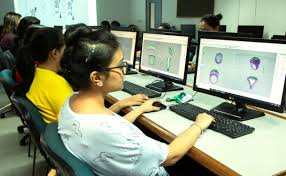Plater
TOR: INFORMATION TECHNOLOGY- INFORMATION TECHNOLOGY ENABLED SERVICES (ITITES)ces Helpdesk Attendant
SECTOR: GEMS & JEWELLERY
SUB-SECTOR: Cast and Diamonds-Set Jewellery
OCCUPATION: Plating
REFERENCE ID: G&J/Q3201
ALIGNED TO: NCO-2004/7313.35
Plater: Also known as ‘Rhodium plater’, in the cast and diamond-set jewellery
manufacturing, Plater uses the Rhodium flashing process for giving bright white
and reflective appearance to the finished jewellery piece.
Brief Job Description: The individual at work applies the layer of Rhodium, on
the surface of the jewellery piece. The individual operates the plating plant or
runs the manual process for applying Rhodium on the finished jewellery piece
for giving bright white and reflective appearance to the precious metal
jewellery.
Personal Attributes: The job requires the individual to have: attention to
details and hand-eye coordination. Safe handling of hazardous chemicals and
integrity in dealing with precious metal such as Gold and Rhodium are also
important
Plate the jewellery with Rhodium or other precious metal
Unit Code G&J/N3201
Unit Title
(Task) Plate the jewellery with Rhodium or other precious metal
Description This OS unit is about giving bright white and reflective appearance to gold jewellery
piece by rhodium plating process, or other colour using another precious metal
Scope This unit/task covers the following:
Collect jewellery the finished piece, consumables and instructions from supervisor
read the job sheet for assessing the materials requirement
receive material and instruction from supervisor
inspect coated or plated areas for defects such as air bubbles or uneven
coverage
Mask for two-tone plating
read design for specific plating requirement
follow design specifications in terms of targeted surface of jewellery piece
required to be plated
mask surface excluded from plating by applying nitro cellulose (lacquer)
dry the masking surface at the room temperature
Clean jewellery piece using Ultrasonic cleaneprepare solution of caustic powder and soap water
clean the jewellery piece in the solution and electro-charge it as per the
operating procedure specified
clean under high pressure steam for removing impurities and solution
dry jewellery piece
Plate the jewellery using Rhodium
prepare a concentration of the degreasing solution
dip the jewellery piece for specified time in the degreasing solution
take out the jewellery piece and dip into plain water and then demineralised
water for cleaning
dip into diluted acid solution for further degreasing
prepare rhodium concentrate solution
set the time parameters of the rhodium plating plant
immerse the jewellery piece in the plating solution for specified time
remove from solution and neutralise the jewellery piece by dipping in water
clean the jewellery piece under high pressure steam and dry
Send jewellery pieces for quality check
rework as per QC suggestions on the missed surfaces
return completed jewellery piece to supervisor
ensure timely delivery
Repair and maintain plating plant
maintain the concentration of solutions for plating as per operating procedure
schedule the annual maintenance
Plate the jewellery with Rhodium or other precious metal
Performance Criteria(PC) w.r.t. the Scope
Element Performance Criteria
Masking jewellery piece To be competent, the user/individual on the job must be able to:
PC1. accurately mask specified jewellery surface for two tone plating
PC2. improve productivity for complex designs, which may take longer to mask
Rhodium plating To be competent, the user/individual on the job must be able to:
PC3. monitor concentration levels of solutions in ultrasonic, degreasing, acid and
plating solutions
PC4. follow steps as per operating procedures for plating
PC5. optimise usage of rhodium, which is most expensive metal
PC6. handle chemicals with care and ensure zero accidents
Productivity To be competent, the user/individual on the job must be able to:
PC7. plan the plating process to ensure optimum use of the plating plant
PC8. deliver number of jewellery pieces plated as per target deliverable
Quality of output To be competent, the user/individual on the job must be able to:
PC9. generate rhodium brightness and spread on the jewellery piece as per job
sheet or client requirement
PC10. minimise errors in masking and plating
PC11. deliver quality control okayed jewellery piece
Knowledge and Understanding (K)
A. Organizational
Context
The user/individual on the job needs to know and understand:
KA1. company’s policies on: quality, incentives, delivery standards, safety and
hazards, integrity and IPR, and personnel management
KA2. importance of the individual’s role in the workflow
KA3. reporting structure
B. Technical
Knowledge
The user/individual on the job needs to know and understand:
KB1. types of Rhodium and masking materials
KB2. the chemical composition, structure, and properties of substances used
KB3. chemical processes and transformations that follow
KB4. plating process planning
KB5. sizes and compositions of objects to be plated, and amounts of electrical
current and time required
KB6. equipment maintenance such as cleaning tanks
KB7. pen plating as an alternative
KB8. potential work hazards while handling and chemicals
Skills (S) [Optional]
A. Core Skills/ Generic
Skills
Basic reading and writing skills
The user/ individual on the job needs to know and understand how to:
SA1. read notes and operating manual of electroplating station
SA2. read company rules and compliance documents required to complete the
work
Calculation skills
The user/individual on the job needs to know and understand how to:
SA3. monitor and measure thicknesses of electroplating on component parts in
order to verify conformance to specifications, using micrometers
SA4. calculate and weigh the correct amount of rhodium requirement for
replenishment
Teamwork and multitasking
The user/individual on the job needs to know and understand how:
SA5. to share work load as required
SA6. it is important to deliver plated jewellery for final QC on time
SA7. to receive feedback from co-workers and QC and improve quality of output
SA8. to share knowledge with co-workers
B. Professional Skills Electroplating
The user/individual on the job needs to know and understand how to:
SB1. assess smoothness of surface to be plated in order to avoid imperfections
after Rhodium plating
SB2. plate that lasts long duration
SB3. present records of the plating plant
Using tools and machines
The user/individual on the job needs to know and understand how:
SB4. to use the right equipment in the plating process
SB5. to understand safety and hazards involved
SB6. to understand tools and machine operations and its usage to be able to
maintain and repair
Problem solving
The user/individual on the job needs to know and understand how to:
SB7. ensure that plating station operates properly with good maintenance ad
replacement of worn plates
Reflective thinking
The user/individual on the job needs to know and understand how:
SB8. improve productivity and increase efficiency based on past working
experience
Critical thinking
The user/individual on the job needs to know and understand how to:
SB9. anticipate process disruption and reasons for delay
Unit Code G&J/N9901
Unit Title
(Task) Maintain IPR of company and respect IPR of other companies
Description This OS unit is about protecting company’s IPR and avoiding infringement to IPR of
other companies
Scope This unit/task covers the following:
Protect company’s Intellectual Property Rights (IPR)
prevent leak of new designs to competitors by reporting on time
be aware of any of company’s product or design patents
report IPR violations observed in the market, to supervisor or company heads
Avoid infringement to IPR of other companies
read copyright clause of the material published on the internet and any other
printed material
consult supervisor or senior management when in doubt about using publicly
available information
report any infringement observed in the company
Performance Criteria(PC) w.r.t. the Scope
Element Performance Criteria
Respecting and
Maintaining IPR
To be competent, the user/individual on the job must:
PC1. be able to spot plagiarism and report
PC2. be aware of patents and IPR
PC3. not be involved in IPR violations
Knowledge and Understanding (K)
A. Organizational
Context
The user/individual on the job needs to know and understand:
KA1. company’s policies on IPR and plagiarism
KA2. reporting structure
KA3. company’s unique product range
B. Technical
Knowledge
The user/individual on the job needs to know and understand:
KB1. patents and IPR laws
KB2. how IPR protection is important for competitiveness of a company
Skills (S) [Optional]
A. Core Skills/
Generic Skills
Communication skills
The user/ individual on the job needs to know and understand how to:
SA1. effectively communicate any observed IPR violations or order leaks
B. Professional Skills Decision making
The user/individual on the job needs to know and understand how to:
SA2. report potential sources of violations
Reflective thinking
The user/individual on the job needs to know and understand to:
SA3. learn from past mistakes and report IPR violations on time
Critical thinking
The user/individual on the job needs to know and understand how to:
SA4. spot signs of violations and alert authorities in time
Coordinate with others
Unit Code G&J/N9902
Unit Title
(Task) Interact with colleagues and seniors
Description This OS unit is about communicating with colleagues and seniors in order to achieve
smooth and hazard-free work flow
Scope This unit/task covers the following:
Interact with supervisor
receive work instructions and raw materials from reporting supervisor
communicate to reporting supervisor about process-flow improvements, product
defects received from previous process, repairs and maintenance of tools and
machinery as required
communicate any potential hazards or expected process disruptions
handover completed work to supervisor
Interact with colleagues within and outside the department
work as a team with colleagues and share work as per their or own work load and
skills
work with colleagues of other departments
communicate and discuss work flow related difficulties in order to find solutions
with mutual agreement
receive feedback from qc and rework in order to complete work on time
Performance Criteria(PC) w.r.t. the Scope
Element Performance Criteria
Interaction with
supervisor
To be competent, the user/individual on the job must be able to:
PC1. understand the work output requirements
PC2. comply with company policy and rule
PC3. deliver quality work on time as required by reporting any anticipated reasons
for delays
Interactions with
colleagues and other
departments
To be competent, the user/individual on the job must be able to:
PC4. put team over individual goals
PC5. be able to resolve conflicts
PC6. learn how to multi-task relevant activities
Knowledge and Understanding (K)
A. Organizational
Context
The user/individual on the job needs to know and understand:
KA1. company’s policies on: preferred language of communication, reporting and
escalation policy, quality delivery standards, and personnel management
KA2. reporting structure
B. Technical
Knowledge
The user/individual on the job needs to know and understand how to:
KB1. communicate effectively
KB2. build team coordination
G&J/N9902 Coordinate with others
14
Skills (S) [Optional]
A. Core Skills/
Generic Skills
Communication skills
The individual on the job needs to know and understand how to:
SA1. read and write preferred language of communication as prescribed by the
company
SA2. read job sheets and interpret technical details mentioned in the job sheet
B. Professional Skills Decision making
The individual on the job needs to know and understand:
SB1. how to spot and communicate potential areas of disruptions to work process
and report the same
SB2. when to report to supervisor and when to deal with a colleague individually,
depending on the type of concern
Reflective thinking
The individual on the job needs to know and understand how to:
SB3. improve work processes by interacting with others and adopting best
practices
Critical thinking
The individual on the job needs know and understand how to:
SB4. spot process disruptions and delays and report and communicate with
solutions
Unit Code G&J/N9905
Unit Title
(Task) Maintain occupational health and safety
Description This OS unit is about being aware of, communicating and taking steps towards
minimizing potential hazards and dangers of accidents on the job and maintaining
occupational health and safety
Scope This unit/task covers the following:
Understand potential sources of accidents
to avoid accidents related to use of potentially dangerous chemicals, sharp tools
and machines
Use safety gear to avoid accidents
wear safety gear such as goggles, mask, gloves, ear plugs
Actively participate in the health and safety awareness campaigns
attend fire drills organised by the company or industrial zone
learn first aid procedure
be alert about designated assembly area in the event of an emergency
read and understand the evacuation and emergency procedures
Communicate to reporting supervisor about:
process flow improvements that can reduce anticipated or repetitive hazards
mishandling of tools, machines or hazardous materials
electrical problems that could result in accident
Performance Criteria(PC) w.r.t. the Scope
Element Performance Criteria
Communicating
potential accident
points
To be competent, the user/individual on the job must be able to:
PC1. spot and report potential hazards on time
PC2. follow company policy and rules regarding use of hazardous materials
PC3. attend and actively participate in the health and safety campaigns organised
by the company
Using safety gear To be competent, the user/individual on the job must be able to:
PC4. use or wear safety gear as per the rules of the company
Knowledge and Understanding (K)
A. Organizational
Context
The user/individual on the job needs to know and understand:
KA1. company’s policies on: safety and hazards and personnel management
KA2. reporting structure
B. Technical
Knowledge
The user/individual on the job needs to know and understand:
KB1. how different chemicals react and what could be the danger from them
KB2. how to use machines and tools without suffering bodily harm
Skills (S) [Optional]
A. Core Skills/
Generic Skills
Communication skills
The individual on the job needs to know and understand how to:
SA1. effectively communicate the danger
Organising skills
The individual on the job needs to know and understand how to:
SA2. keep all the tools in an organised manner so as to avoid accidents
SA3. keep the work environment safe and clean
B. Professional Skills Decision making
The individual on the job needs to know and understand how to:
SB1. report potential sources of danger
SB2. follow prescribed procedure in the event of an accident
SB3. wear appropriate safety gear to avoid an accident
Reflective thinking
The individual on the job needs to know and understand to:
SB4. learn from past mistakes regarding use of hazardous machines or chemicals
Critical thinking
The individual on the job needs to know and understand how to:
SB5. spot danger
Decision making
The individual on the job needs to know and understand how to:
SB6. report potential sources of danger
SB7. follow prescribed procedure in the event of an accident
SB8. wear appropriate safety gear to avoid an accident
Keywords /Terms Description
Sector Sector is a conglomeration of different business operations having similar
business and interests. It may also be defined as a distinct subset of the
economy whose components share similar characteristics and interests.
Sub-sector Sub-sector is derived from a further breakdown based on the
characteristics and interests of its components.
Occupation Occupation is a set of job roles, which perform similar/ related set of
functions in an industry.
Function Function is an activity necessary for achieving the key purpose of the
sector, occupation, or an area of work, which can be carried out by a
person or a group of persons. Functions are identified through functional
analysis and form the basis of OS.
Sub-function Sub-functions are sub-activities essential to fulfil the achieving the
objectives of the function.
Job role Job role defines a unique set of functions that together form a unique
employment opportunity in an organisation.
Occupational Standards
(OS)
OS specify the standards of performance an individual must achieve
when carrying out a function in the workplace, together with the
knowledge and understanding they need to meet that standard
consistently. Occupational Standards are applicable both in the Indian
and global contexts.
Performance Criteria Performance criteria are statements that together specify the standard of
performance required when carrying out a task.
National Occupational
Standards (OS)
NOS are occupational standards which apply uniquely in the Indian
context.
Qualifications Pack (QP) QP comprises the set of OS, together with the educational, training and
other criteria required to perform a job role. A QP is assigned a unique
qualifications pack code.
Unit Code Unit code is a unique identifier for an Occupational Standard, which is
denoted by an ‘N’
Unit Title Unit title gives a clear overall statement about what the incumbent
should be able to do.
Description Description gives a short summary of the unit content. This would be
helpful to anyone searching on a database to verify that this is the
appropriate OS they are looking for.
Scope Scope is a set of statements specifying the range of variables that an
individual may have to deal with in carrying out the function which have
a critical impact on quality of performance required.
Knowledge and
Understanding
Knowledge and understanding are statements which together specify the
technical, generic, professional and organisational specific knowledge
that an individual needs in order to perform to the required standard.
Organisational Context Organisational context includes the way the organisation is structured
and how it operates, including the extent of operative knowledge
managers have of their relevant areas of responsibility.
Technical Knowledge Technical knowledge is the specific knowledge needed to accomplish
specific designated responsibilities.
Core Skills/ Generic
Skills
Core skills or generic skills are a group of skills that are the key to learning
and working in today’s world. These skills are typically needed in any
work environment in today’s world. These skills are typically needed in
any work environment. In the context of the OS, these include
communication related skills that are applicable to most job roles.
Keywords /Terms Description
CAD Computer Aided Design
CAM Computer Aided Manufacturing
IPR Intellectual Property Rights
NOS National Occupational Standard(s)
NVQF National Vocational Qualifications Framework
NSQF National Qualifications Framework
NVEQF National Vocational Education Qualifications Framework
QP Qualifications Pack
CRITERIA FOR ASSESSMENT OF TRAINEES
Job Role Plater
Qualification Pack G&J/Q3201
Sector Skill Council Gem & Jewellery
Guidelines for Assessment
- Criteria for assessment for each Qualification Pack will be created by the Sector Skill Council. Each
Performance Criteria (PC) will be assigned marks proportional to its importance in NOS. SSC will also lay down
proportion of marks for Theory and Skills Practical for each PC. - The assessment for the theory part will be based on knowledge bank of questions created by the SSC.
- Individual assessment agencies will create theory question papers for candidates at every
examination/training centre. (as per assessment criteria below) - Individual assessment agencies will create practical tests for skill evaluation for candidates at every
examination/training centre. (as per assessment criteria below) - To pass the Qualification Pack, every candidate should score a minimum of 50% in theory and 70% in
practical to successfully clear the assessment. - In case of successfully passing only certain number of NOS’s, the candidate is eligible to take subsequent
assessment on the balance NOS’s to pass the Qualification Pack.









